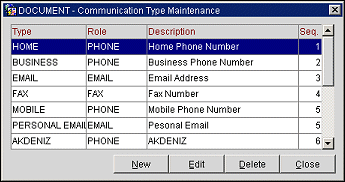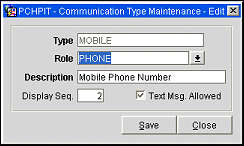
Communication Types
On every profile for individuals, companies, agents contacts, sources, and groups, it is possible to record the Communication Type used to communicate with that profile. A communication type identifies the electronic means for communicating (as opposed to Address Types that identify the profile's physical street or P.O. Box address). Communication Types include phone numbers, email addresses, fax numbers, and web pages. Multiple communication type entries may be made for a profile. As an example, a company profile may have a fax phone number and a business phone number. You also might configure communication types for a home telephone number and cell telephone number.
By accessing the Communication Type Maintenance screens you can add or edit communication types that will be available for users to select when they enter communication type information for the profile. In PMS, select Configuration>Profile>Communication Types. In ORS, select Configuration>Profile>Phone Types. (Communication Type is also referred to as Phone Type.) The Communication Type Maintenance screen displays.
Each communication/phone type you create is associated with what is called a phone role. Phone roles indicate the method (category) of communication such as Phone, Fax, Email, Pager, and Web Page and are pre configured in Opera; provided as SID data.

Type. An abbreviation that identifies the specific communication function provided within Opera (e.g., Business Phone, Fax Phone, Email, Pager Phone, Mobile Phone, Cell Phone, Web Site).
Role. A system-defined designation that identifies the category of communication type (Phone, Fax, Email, or Web Page. In ORS, the additional category of Email for Request is available. See Adding and Editing Communication Types, below, for more information).
Description. A descriptive phrase that defines the communication type (e.g., Manager's Home Number, Fax Number, Email Address, Web Site).
Sequence. The order of succession for items to appear in a list by assigning them a numeric order.
New. Select New to create a new communication type. The Communication Type - New screen appears.
Edit. Select Edit to change an existing communication type. The Communication Type - Edit screen appears.
Delete. Select Delete to remove an existing communication type.
Close. Select Close to exit out of the Communication Type Maintenance screen.
To add a new communication type, select New from the Communication Type Maintenance screen. To edit an existing communication type, select Edit. The Communication Type Maintenance - New/Edit screen displays. Provide the type, role, description and display sequence number, then select Save to return to the Communication Type Maintenance screen.

Type. Enter the name that identifies the specific communication function.
Role. Select from the LOV the category of communication type: Phone, Fax, Email, or Web Page.
Note: In ORS, when the OPR<version number>ORS is activated, the additional role of Email for Request is available. This email address is used with the Profile Requests feature. When selected, and Email for Request information is entered on the profile, this email for request address appears on the Profile Requests New or Edit screen by default (when Options>Requests>New or Edit is selected) even though other email addresses may exist. This Email for Request address does not download to PMS at the property level; nor can it be deleted or replaced by changes made at the property level in PMS.
Description. Enter a descriptive phrase that defines the communication type (e.g., Manager's Home Number, Personal Fax Number, Company Web Site).
Display Seq. Assign the communication type a number to appear in a list for selection.
Text Msg. Allowed. Available when the General>Text Message Handling application function is set to Y and the Role is set to Phone, select the check box to indicate that this communication type will allow for text messages.